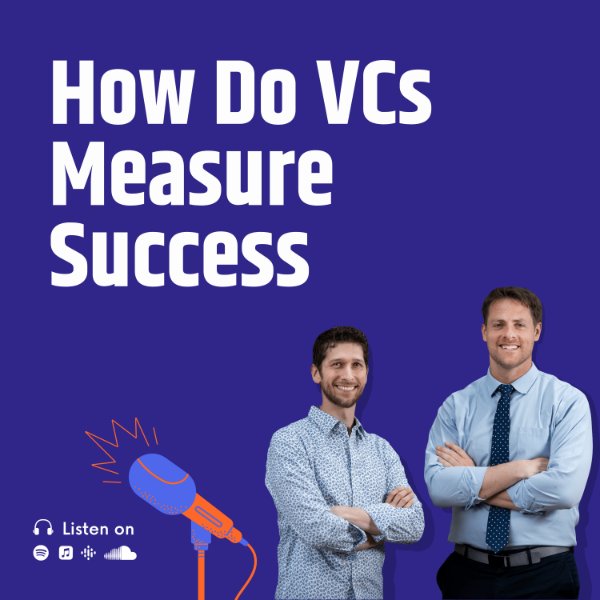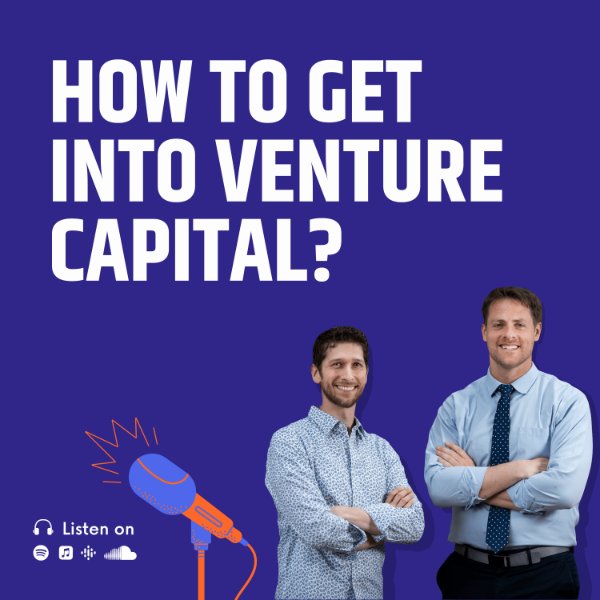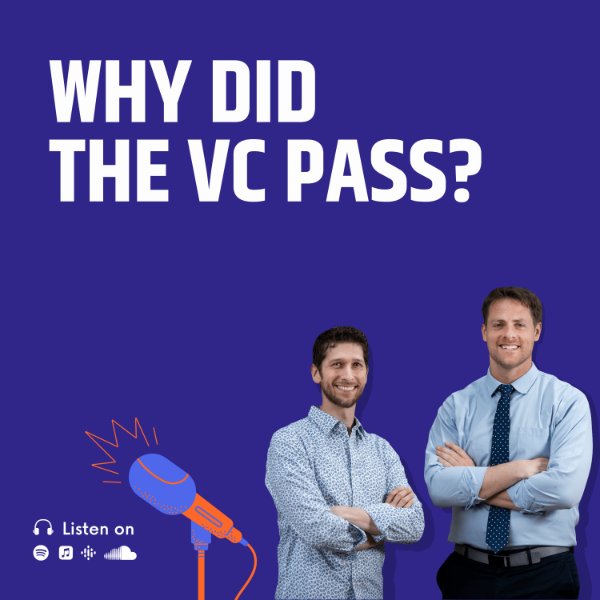Jon: Congratulations, Peter, for making 100,000 downloads on the Venture Capital podcast.
Peter: Congratulations, Jon. That was that was really all, Jon. I just show up here. Jon makes. Jon is the magic that makes us sing.
Jon: But your YouTube channel is passed on a thousand, right?
Peter: Yeah, probably.
Jon: Yeah. See? So, like, it's a team. Teamwork makes the dream work.
Peter: That's right.
Jon: So, anyways, we just want to thank all of you before beginning the show. It was kind of like a major milestone.
Peter: Yeah. You know, what really surprised me is that puts us in the top 5% of all podcasts.
Jon: Pretty cool. According to Listen Notes.
Peter: Can't listen notes.
Jon: And I think a lot of the podcast players share data with listeners, so they should be fairly accurate.
Peter: Yeah, in either way. The other thing that I really loved as this week was, or a couple of weeks ago was Utah Tech Week, and it was super fun meeting with a lot of the people that listen to the podcast and hearing the things they like, the things they don't like. Getting feedback on how we can do a better job.
Peter: So that was great because, you know, sometimes you just talking to this like Mike and you don't know if anybody actually cares. And it was it was really fun to talk to people who care enough to to say, Hey.
Jon: Are those hundred thousand downloads real or they fake?
Peter: That's right. Yeah. They're like, do they just download them or do they actually listen?
Jon: How do you get the point? People recognize you now from the podcast before other things. They're like, You're the podcast guy, or you're Peter Harris who has a podcast.
Peter: I don't know. It was kind of a mix. I think most people kind of know me beforehand, but then they were like, Hey, I really like the podcast. Or, you know, I listened to this episode and blah, blah, blah.
Jon: As a VC, what connections have you have come from it? There's the one out of Israel, right?
Peter: Yeah. So that was cool. what other connections? I mean, I've had a lot of people reach out just, you know, to get advice, feedback. trying to think if there are any other, like, super meaningful connections so far. But that's okay.
Jon: Yeah. Good, good, good. Well, to begin, today's episode was year the Dark Art of Startup Valuations.
Peter: Yeah.
Jon: So I don't know if it's really so dark. I mean, I think it's easy. Well, so if I did not have my network, it probably would be a lot tougher. I feel like most valuations are based upon where? Like what your prior career success has been for the most part.
Peter: Yeah, I think that's definitely part of it for sure.
Jon: Like right now, if you're if you're raising up a pitch deck, you're probably raising a 2 to 5 million pre money.
Peter: Yeah.
Jon: And if you've had significant traction in the past, you're at 20. If you've had a really good exit, you might be at 40.
Peter: And we're talking just just a pitch deck. You got no product.
Jon: Pitch deck and or maybe a team, but like your pretty product.
Peter: Pre product. Yeah. That thing. I think some of those numbers, I mean, they definitely exist. Right. But some.
Jon: Of those are like.
Peter: The guy, one of the founder co-founders of Salesforce, that just raised $1,000,000,000 pre with just a pitch deck. Right. I think there are the exceptions to the rule out there. But I think I think what I'm seeing right now is most like pre pre product companies are, are raising and the like I don't know. Yeah. 3 to $10 million range.
Jon: Which on which side of the 3 to 10 or to three or.
Peter: More to three. More to three. Yeah.
Jon: Yeah. And a lot of deals this time compared to last year, what half of the deals are. But there's about half the number of deals being funded.
Peter: Yeah. Yeah, it's a lot fewer deals. Yeah. I was talking to a friend this today at lunch, and we were talking about, you know, what are the metrics to raise a series A? And I was like, well, I mean, the metrics are pretty much the same as what they've been for a long time, which is kind of like call it 1 to 2, closer to two than 1 million and in revenue or RR and like, you know, really good metrics around everything else.
Peter: So like low churn good and ah, low customer concentration, good renewal rates like that sort of stuff. And I don't think that's changed. But I think in 2021 it was like if you had all that stuff, you would definitely get funded. And now it's like you have that's table stakes. You have to have all that to get funded.
Peter: But just because you have it all doesn't mean you will get funded. but going back to valuation, I just thought it was would be interesting to talk a little bit about it because I get asked all the time like, how do companies, how do you put a value on something? Right? And yeah, so I thought it would be an interesting episode to talk about, like what are the things that going in to account when ABC and an entrepreneur are coming to terms on valuation?
Peter: I'm curious, what are your thoughts on the founder side? Like, how do you think about valuation when you're approaching a VC and putting out a number like, Hey, invest in my company at this, at this, this amount?
Jon: I think the general rule is the person who speaks first loses right?
Peter: Okay. Sometimes I think.
Jon: You should go in knowing your market comps. Probably like a range.
Peter: Okay.
Jon: like, so if I were trying to raise right now off of a pre product, I'd try to push for 5 to 10. But I'm trying to say, Hey, we're probably somewhere in this range. Yeah. And I'd have the lead investor kind of, you know, I mean typically the lead investors who's all who ultimately chooses, right? And then your choices, whether you accept the lead investor or not.
Peter: Sure. Sure. On what they're willing to pay for it. Yeah. when you're going through that process. So you say. But part of it is like, how much are you going to raise to right now? How much solution you're going to take.
Jon: And the ultimate vision and or and this is pre traction, right?
Peter: Sure. But even like post traction, Right. How do you how do you put a value on something that's pre product But how do you also put a value on something that's I don't know, probably like somewhere in the range of 10 to 50 K Amra. Right. I mean it's still kind of challenging. I mean.
Jon: The way I see a lot of my, my, the, the founder friends look at is just what are, what are market comps? Who's doing what? You know, working through the friends. I mean, if you have revenue, I think the general rules, if you're lucky, you're trying to get a 4 to 6 X multiple off of revenue.
Jon: But with your revenue, it it changes the valuation game versus. Yeah, hey, I have a pitch Jack to hey I've got no revenue.
Peter: My experiences the multiples on revenue in the early stages tend to be a lot higher than 4 to 6.
Jon: Okay.
Peter: I mean, because think about this way, like how hard is it to go from 0 to 1000000 in revenue? It's actually pretty challenging.
Jon: Do you think it's tough?
Peter: So if I put it like a6x multiple on your revenue, now you're valued at like 6 million. I think most people would be like, that's that's really low. It should be at least double that. Right. So now you're looking at closer to like 12 x. So in my my experience, once you get revenue in the early stages, now though, further along you go, the more like revenue multiples actually start mattering a lot more, but you're probably closer to like the 10 to 20 X range on on revenue.
Peter: And you're also looking a lot more at like next year's revenue. Right. So you're like, okay, this year we did a million, but next year we have visibility to four. Right? So maybe it's like six x forward looking revenue. Right. Which all of a sudden puts you in the like, you know, $24 million range, which feels a little little closer.
Jon: I think the people who get the the large outsize valuations the VCs are typically looking at from top down. Yeah. How big is the market size? How much funding are you gonna have to have him around. Yeah. And how to how do I get my desired IRR.
Peter: Yeah. And I think I think this definitely Right. So yeah. If, if you're attacking a market that's really, really big, you all things being equal, are going to get a higher valuation, right? If you're attacking a market that is very crowded, probably all things being equal, you're going to get a lower valuation. You're going to have to fight tooth and nail.
Peter: yeah, There's a whole repeat founder side of it, right? Or first time founder side of it. How strong your team is, how good the metrics are. and then the other thing that's like kind of the art of all of this is the and this is why you can get much higher multiples on revenue at the early stages and at the later stages is because you want to make sure that the founders have enough equity in the company to maintain enough equity in the company after round after round after round of funding, because there's a lot of companies that raise it to love a valuation to early on and they raise too
Peter: much money. Founders don't end up owning enough of the company and by the time and it doesn't feel that way at the time right because the founder my own you know 40% of the business at the early stages and that feels like that's kind of a lot or still like a very meaningful amount. But you have to take into consideration that every subsequent round it theoretically could get cut in half.
Peter: And so by the time you make it to series C, you're sitting at like, you know, sub 10% and all of a sudden that starts to make investors nervous, you know. So there's also that element of, okay, I want to make sure that the founder has enough equity at this stage of fundraising so that given the needs that they're going to have in the future, they still will own enough to be incentivized.
Peter: And then the other piece that is something that really honestly bugged me a lot is that is how often valuation is determined by the check size. The venture fund needs to write and has nothing to do with the core underlying business. And I think that happened a ton in 2021, but still continues to happen. And that's just because, like venture funds, they need to invest enough, they need to own enough in the company so that if that company becomes a funder.
Peter: TURNER which is super important for venture, right? Because it's this whole power dynamic where like only one or two deals are going to return your fund and drive all your economics. So you need to own enough in that one company. You have to own enough in all of the companies you invest in because you don't know which one is going to be successful so that the one that is successful.
Peter: You have enough ownership to return your fund. And the larger your fund gets, the larger that check needs to be. And so I know so many instances where founders are like they go out and they want to raise $5 million because they feel like that's what they need to hit plan. And the VCs, you know, they're like, okay, we're going to raise five on 15.
Peter: We're going to sell 25% of the business, right? That feels like healthy at a series A, what have you. And the VC comes in and says, like, I need to write a $10 million check into this company. Right? And I need to own like at least 20%. And so they convinced the founder like, okay, we're going to write this, this, this $10 million check.
Peter: We're going to take less ownership. Right? And that's that's the carrot for the entrepreneur. And we're going to give you this like great valuation of like 40 pre, and now the founders, like in this unenviable position of having to grow into that valuation, right? Because going back to multiples, if I'm sitting at like 2 million. RR Right.
Peter: And my multiple on that 15 pre, it was like seven and a half X that's, you know that's, it's easily doable to like grow your business from like 2 million to to 4 million or 5 million. Right? But then all of a sudden I'm being valued at 40 pre on 2 million. Now I've got I'm sitting at like a tax revenue multiple.
Peter: And knowing that multiples compress over time, like, if the next round, I'm going to get valued at a ten x multiple and I just want to be B flat. That means I got to be doing I could be doing 4 million. I got a double. But if I really want an up round and really I want to double like from one round to the next, which is really kind of should be the goal for most entrepreneurs is to double valuation every round.
Peter: so we're doing a 50 to 100% increase, right? Should be a rough goal as a founder. well, okay, that means I need to go from 2 to 8 and I got 10 million to do it right. And I don't know, I think it's curious what your thoughts are. I think it's, it can be really challenging to be that disciplined when you've got that much cash sitting in the bank, you have that much pressure.
Peter: You got to put it to work, you've got to grow. You don't always know everywhere. That's going to be the most efficient use of that. And so it gets it becomes challenging to deploy it effectively. And the clock is ticking, right? So it's I don't know. What are your thoughts, Jon?
Jon: I mean, I think it's I mean, one of the spots I've never been No. Said here's a $20 million check versus 10 million.
Peter: Yeah.
Jon: I think the a lot of the pressure right now that I'm watching as a founder is different people are not like they can't just raise again and so it just companies are going belly up and like motto posted about this yesterday about like well where's your will like you had a vision and continue the vision but do it economics people are just falling out whether that's loyalty or just loyalty.
Peter: Yeah I'm like I think it's it's a challenging spot like the rock and a hard place today. I was thinking about this earlier. Is that as a founder, your insiders are telling you get to break even. Right?
Peter: And extend the runway. But the problem that you have is that outside investors are going to look at that and they're not excited about the fact that you're break even if you're not growing. And it's like you need growth to fundraise, but you need profitability to survive. And those are that's the rock and a hard place. And it you know, it's frankly like it's really challenging to run that that middle road because, yeah, you can get to break even.
Peter: But then like, what's the point of you can't raise more money? Right. And you're not growing. Then it's like, okay, we got to break even and we survived to live another day. But now what? Right. Because. Because all the VC is like, that's kind of dumb, But that also makes sense. Like, we're not excited about investing in companies that have, like, plateaued, right?
Peter: Even if they are break even, we want to invest in, like, things that are rocket ships and growing super fast, even if they're burning. So, yeah, it's.
Jon: It's up to.
Peter: You. Just the challenging spot.
Jon: The sharp edge. And once you're off your, your goal and you're done.
Peter: Yeah.
Jon: Or you can regroup and pick up the the bodies.
Peter: Yeah. Yeah. And maybe, maybe the advice is that, you know, you get to break even, and then you go find a buyer. Right. You exit the thing and you move on to the next the next thing. I think the here's what I will say are the mistakes that I've seen founders that don't make necessary cuts early and conserve cash, and just run their startup into a wall.
Peter: I've seen that happen. I think that's a mistake. I think founders that just kind of like, give up and throw in the towel prematurely. I think I've seen that a bunch. I think that can be a mistake because, like, do as a venture investor, do I really want to back the person that like, didn't you know? Yeah, it's a tough spot.
Peter: Super tough spot to be in. So like no criticism there per se, but like, all things being equal, am I going to fund that founder that like made huge personal sacrifices and cuts and, you know, try to keep the business going or the one that just like threw in the towel and was like, this is too hard. I'm going back to my job.
Peter: And, you know, we're just shutting the whole thing down. I'm probably going to fund the the one that, you know, is more committed and try to make it happen, right. Even if it ultimately didn't. And I've been on both sides of that. I've seen founders that like, frankly, I'd kind of written off the business and they persevered and have built incredible businesses.
Peter: And I've also been in ones where, yeah, they, they, they try to persevere as long as they could and eventually ran out of cash and had to shut it down. But in both cases, like I'm excited to back that founder ten times more than I am to back to back the founder that was just like, This is hard.
Peter: We're rolling it up, shutting it down. without at least even finding, like, a soft landing through, like, another potential acquirer of the business or, or what have you. So anyways, I think, I think it's a tough channel to be navigating. Generally speaking, I would say like, you should not sacrifice all growth for profitability, but most companies can cut a lot more than they think they can without sacrificing too much growth.
Jon: So what's that number of 20%?
Peter: I don't know. I think it's so company dependent. Like we're in a deal right now where we I was talking to the CEO and he was like, he's like he kind of came in and cleaned house and he was like, look, we we don't need to give daily massages to all of our employees, Right? That is an expense that will not hurt growth.
Peter: So we cut it. And he found like something crazy, like over $10 million of not on growth productive expense that could be cut out of the business and flipped him from being burning a ton of money every month to being profitable without sacrificing top line growth. I'm in another company where, like they cut some of their marketing staff and realized that like revenue actually went up.
Peter: Right. And they're like, Wow. Like, we were doing all these things that we thought were helpful but turned out to not be necessary. Right. We were kind of spinning our wheels on some things. like, there are just so many examples of that where, like, when money is easy to get people, they hire, like, crazy to solve small problems.
Peter: And when it's time to car, it's really about going through analyzing every single line item and identifying like, is this any damages and there's a must have. Anyways, this was like along side tangent from valuation.
Jon: Yeah.
Peter: So my boss was.
Jon: Super super helpful. So basically valuations for pre-seed companies are 3 to 10 million. Probably closer to five.
Peter: Yeah, probably closer to 3 to 5. Yeah.
Jon: Okay.
Peter: And like you said, anticipate giving up somewhere between 10 to 20% of your company at the early stages. Right. It I mean, it kind of ranges. So it's like you kind of give up like 20 to 30% and then 15 to 25% and then 10 to 20%. And then you kind of just lock in 10% after that. So, yeah, once you hit kind of series B series C stage, you should anticipate you're giving up about 10% of the company every subsequent fundraised.
Jon: So sounds good. Well, thanks, guys. If you've got more questions about valuations, we're going to wrap up this episode, but join us. Venture capital firm leave a review. Leave a comment. Leave a five story. Five stars. Four stars, whatever you think. We want to hear your feedback. Six stars is what Peter's hoping for.
Peter: Only 610% authentic. All right, do it.
Jon: Sounds good. See you on the next podcast, guys.





